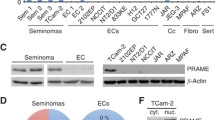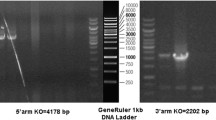Abstract
PLU-1, a large multi-domain nuclear protein with strong transcriptional repression activity, is a member of the ARID family of DNA binding proteins. In previous studies, high levels of expression of Plu-1 mRNA and PLU-1 protein were detected in breast cancers, while expression in normal adult tissues was detected only in the testis, ovary and transiently in the mammary gland of the pregnant female. Due to its high levels of expression in the testis and to its specific relationship to cancer, PLU-1 has been proposed to belong to the family of testis-cancer antigens. In this study we attempted to determine putative functions for PLU-1 during spermatogenesis. To address this, we analysed the pattern of expression and localisation of this protein in mouse testicular cells during postnatal development and adulthood. Using in situ hybridisation and immunostaining of testis sections we show that Plu-1 mRNA and PLU-1 protein are both highly expressed in the mitotic spermatogonia. Expression is reduced dramatically in the early prophase I stages (zygotene, leptotene), but reappears at pachytene and is still detectable in diplotene cells. We also found that PLU-1 localises diffusely over the nucleus, which indicates a potential chromatin binding ability of this protein. Consistent with this notion, we found that PLU-1 is present in the chromatin fraction in biochemical cell fractionation experiments using both somatic and meiotic cells. Our data point to a role for PLU-1 in meiotic transcription, which may be restricted to certain meiotic stages and may be mediated by the ability of this protein to associate with the chromatin.




Similar content being viewed by others
References
Aasland R, Gibson TJ, Stewart AF (1995) The PHD finger: implications for chromatin mediated transcriptional regulation. Trends Biol Sci 20:56–59
Agulnick AI, Mitchell MJ, Mattei MG, Lerner JL, Woods DR, Bishop CE (1994) A mouse Y chromosome gene encoded by a region essential for spermatogenesis and expression of male-specific minor histocompatability antigens. Hum Mol Genet 3:873–978
Barrett A, Madsen B, Copier J, Lu PJ, Cooper L, Scibetta AG, Burchell J, Taylor-Papadimitriou J (2002) PLU-1 nuclear protein, which is upregulated in breast cancer, shows restricted expression in normal human adult tissues: a new cancer/testis antigen? Int J Cancer 101:581–588
Bellve AR, Cavicchia JC, Millette CF, O'Brien DA, Bhatnagar YM, Dym M. (1977) Spermatogenic cells of the prepuberal mouse: isolation and morphological characterization. J Cell Biol 74:68–85
Chen YT, Old LJ (1999) Cancer-testis antigens: targets for cancer immunotherapy. Cancer J Sci Am 5:16–17
Clermont Y (1972) Kinetics of spermatogenesis in mammals: seminiferous epithelium cycle and spermatogonial renewal. Physiol Rev 52:198–236
Cohen PE, Pollard JW (2001) Regulation of meiotic recombination and prophase I progression in mammals. Bioessays 23:996–1009
Dallas PB, Pacchine S, Wilsker D, Bowrin V, Kobayashi R, Moran E (2000) The human SWI/SSNF complex protein, p270, is an ARID family member with nonsequence-specific DNA binding activity. Mol Cell Biol 20:3137–3146
De Plaen E, Arden K, Traversari C, Gaforio JJ, Szikora JP, De Smet C, Brasseur F, van der Bruggen P, Lethe B, Lurquin C et al (1994) Structure, chromosomal localization and espression of 12 genes of the MAGE family. Immunogenetics 40:360–369
de Wit NJW, Weidle UH, Ruiter DJ, van Muijen GNP (2002) Expression profiling of MMA-1A and splice variant MMA-1B: new cancer/testis antigens identified in human melanoma. Int J Cancer 98:547–553
Dobson MJ, Pearlman RE, Karaiskakis A, Spyropoulos B, Moens PB (1994) Synaptonemal complex proteins: occurrence, epitope mapping and chromosome disjunction J Cell Sci 107:2749–2760
Falzon et al 1993
Goedecke W, Eijpe M, Offenberg HH, van Aalderen M, Heyting C (1999) Mre11 and Ku70 interact in somatic cells, but are differentially expressed in early meiosis. Nat Genet 23:194–198
Gregory et al 1996
Herrsacher RF, Kaplan MH, Leisz DL, Das C, Scheuermann R, Tucker PW (1995) The immunoglobulin heavy chain matrix-associating regions are bound by Bright: a B cell specific trans-activator that describes a new DNA binding protein family. Genes Dev 9:3067–3082
Huckins C, Oakberg EF (1978) Morphological and quantitative analysis of spermatogonia in mouse testes, using whole-mounted seminiferous tubules. The normal testes. Anat Rec 192:519–528
Huh S, Hatini V, Marcus RC, Li SC, Lai E (1999) Dorsal-ventral patterning defects in the eye of BF-1-deficient mice associated with a restricted loss of shh expression. Dev Biol 211:53–63
Lu PJ, Sundquist K, Baeckstrom D, Poulsom R, Hanby A, Meier-Ewert S, Jones T, Mitchell M, Pitha-Rowe P, Freemont P, Taylor-Papadimitriou J (1999) A novel gene (PLU-1) containing highly conserved putative DNA/chromatin binding motifs is specifically up-regulated in breast cancer. J Biol Chem 274:15633–15645
Madsen B, Poulsom R, Hall D, Lu PJ, Scott K, Shaw A, Burchell J, Freemont P, Taylor-Papadimitriou J (2002) Characterisation and developmental expression of Mouse Plu-1, a homologue of a human nuclear protein (PLU-1) which is specifically up-regulated in breast cancer. Mech Dev Gene Expression Patterns 2:275–282
Moens PB (1995) Histones H1 and H4 of surface-spread meiotic chromosomes. Chromosoma 104:169–174
Padmore R, Cao L, Kleckner N (1991) Temporal comparison of recombination and synaptonemal complex formation during meiosis in S. cerevisiae. Cell 66:1239–1256
Peters HNA, Balling RQ (1998) Pax genes and organogenesis: Pax9 meets tooth development. Eur J Oral Sci 106:38–43
Peters AH, Plug AW, van Vugt MJ, de Boer P (1997) A drying-down technique for the spreading of mammalian meiocytes from the male and female germline. Chromosome Res 5:66–68
Poulsom R, Longcroft JM, Jeffery RE, Rogers LA, Steel JH (1998) A robust method for isotopic riboprobe in situ hybridisation to localise mRNAs in routine pathology specimens. Eur J Histochem 42:121–132
Quadbeck-Seeger C, Wanner G, Huber S, Kahmann R, Kamper J (2000) A protein with similarity to the retinoblastoma binding protein 2 acts specifically as a repressor for gene regulated by the b mating type locus in Ustilago maydis. Mol Microbiol 38:154–166
Roeder GS (1997) Meiotic chromosomes: it takes two to tango. Genes Dev 11:2600–2621
Saha V, Chaplin T, Gregorini A, Ayton, Young BD (1995) The leukemia-associated protein (LAP) domain, a cysteine-rich motif, is present in a wide range of proteins, including MLL, AF10, and MLLT6 proteins. Proc Natl Acad Sci U S A 92:9737–9741
Senior PV, Beck F, Walker RA, Varley JM (1988) The localization of laminin mRNA and protein in the postimplantation embryo and placenta of the mouse: an in situ hybridization and immunocytochemical study. Development 104:431–446
Stassen MJ, Bailey D, Nelson S, Chinwalla V, Harte P (1995) The Drosophila trithorax proteins contain a novel variant of the nuclear receptor type DNA binding domain and an ancient conserved motif found in other chromosomal proteins. Mech Dev 52:209–223
Takei Y, Swietlik M, Tanoue A, Tsujimoto G, Kouzarides T, Laskey R (2001) MCM3AP, a novel acetyltransferase that acetylates replication protein MCM3. EMBO Rep 2:119–123
Tan K, Shaw AL, Madsen B, Jensen K, Taylor-Papadimitriou J, Freemont PS (2003) Human PLU-1 has transcriptional repression properties and interacts with the developmental transcription factors BF-1 and PAX9. J Biol Chem Submitted
Tarsounas M, Moens PB (2001) Checkpoint and DNA-Repair proteins are associated with the cores of mammalian meiotic chromosomes. Curr Top Dev Biol 51:109–134
Tarsounas M, Pearlman RE, Moens PB (1999) Meiotic activation of rat pachytene spermatocytes with okadaic acid: the behaviour of synaptonemal complex components SYN1/SCP1 and COR1/SCP3. J Cell Sci 112:423–434
Tarsounas M, Davies D, West SC (2003) BRCA2-dependent and independent formation of RAD51 nuclear foci. Oncogene 22:1115–1123
Van den Eynde B, Peeters O, De Backer O, Gaugler B, Lucas S, Boon T (1995) A new family of genes coding for an antigen recognised by autologous cytolytic T lymphocytes on a human melanoma. J Exp Med 182:689–698
Wilsker D, Patsialou A, Dallas PB, Moran E (2002) ARID proteins: a diverse family of DNA binding proteins implicated in the control of cell growth, diferentiation and development. Cell Growth Differ 13:95–106
Acknowledgements
We thank Rosemary Jeffery, Jan Longcroft and Toby Hunt for skilled assistance in the in situ hybridisation studies, and Christian Zierhut and Samantha Santagelo for critical reading of this manuscript. This work was supported by Cancer Research UK (formerly ICRF), B.M. was supported by a Marie Curie Fellowship from the European Commission and M.T. by a fellowship from the European Molecular Biology Organization.
Author information
Authors and Affiliations
Corresponding author
Additional information
Communicated by P.B. Becker
Bente Madsen and Madalena Tarsounas contributed equally to the work described in this article
Rights and permissions
About this article
Cite this article
Madsen, B., Tarsounas, M., Burchell, J.M. et al. PLU-1, a transcriptional repressor and putative testis-cancer antigen, has a specific expression and localisation pattern during meiosis. Chromosoma 112, 124–132 (2003). https://doi.org/10.1007/s00412-003-0252-6
Received:
Accepted:
Published:
Issue Date:
DOI: https://doi.org/10.1007/s00412-003-0252-6




